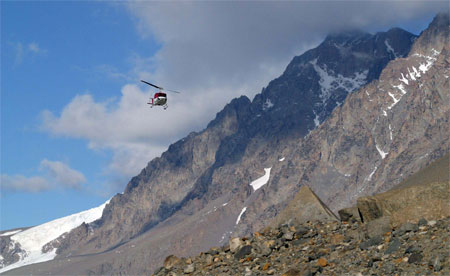Page 2/2 - Posted September 18, 2009
The good news is that because LARISSA is an integrated project, the scientists are all dependent on one another’s results, so each team has an appreciation for what the others are doing, according to Lisa Clough, current NSF program manager for the LARISSA project. “Without a doubt this is a complicated logistic challenge, but when you hear the scientific interactions that have already taken place at planning meetings, on phone calls, and certainly the synergisms that will continue on the cruise and beyond, it’s worth it,” she noted. Oceanographer Bruce Huber “That was really the first time we got a comprehensive look at the oceanography along there,” he said. While similar in scope to Ice Station Weddell, LARISSA is probably a “little more challenging perhaps because we’re trying to do so much from one platform,” Huber added. “I think therein lies the greatest challenge. We’re pushing the ship and the people on the ship to the absolute max, so everything has to be extremely well organized.” Weather is the most obvious risk to the ambitious plan, particularly for flying the helicopters. There are also restraints on how the helos can operate even when the sun is shining, such as a range limit of 24 kilometers for flying over open water. “We’re very concerned about the weather to get everything done. By having two helicopters, with good weather and good conditions, we’re going full tilt,” Jenkins said. Certain coring operations to collect seafloor sediments will also affect shipboard operations. Jenkins said the jumbo piston coring system will require a clear deck for safety reasons. “That requires the helo deck be cleared because there’s a large turning block that we set on the deck to turn the cable for deploying that coring system,” he explained. “It’s a pretty dangerous, heavy, intensive operation.” Other wild cards could come into play after the ship arrives at the site of the former ice shelf. Maria Vernet “This is a pretty high-risk approach in that we hope the sea ice is open enough so we can do the work we want,” Vernet said. The Palmer is actually an icebreaker — and while there’s little chance the ship could become stuck a la Shackleton’s Endurance — thick sea ice will slow the ship and cause it to burn more fuel to forge a channel. Said Scambos, “I’m not worried about getting trapped, but it may restrict what we can do. We’re planning like we can go anywhere we want, but we’ll see if that’s really the case.” There is some good news on that front, according to Jenkins. He said sea ice conditions in the area are projected to be favorable when the Palmer arrives in January. “It’s been open water in a lot of that area and that’s kind of what we’re hoping for. But it could change,” he said. A smooth trip and a successful science cruise for a project as large and complex as LARISSA will provide more than rich new datasets for this rapidly changing system, Mosley-Thompson noted. “LARISSA is a very important project,” she said. “It’s imperative that we’re all successful individually, but it’s even more important that we’re collectively successful because this could be a new mode of scientific and logistical operation.” NSF-funded research in this story: Eugene Domack, Hamilton College, Award No. 0732467 |



For USAP Participants |
For The Public |
For Researchers and EducatorsContact UsU.S. National Science FoundationOffice of Polar Programs Geosciences Directorate 2415 Eisenhower Avenue, Suite W7100 Alexandria, VA 22314 Sign up for the NSF Office of Polar Programs newsletter and events. Feedback Form |


